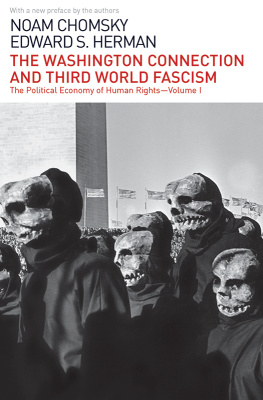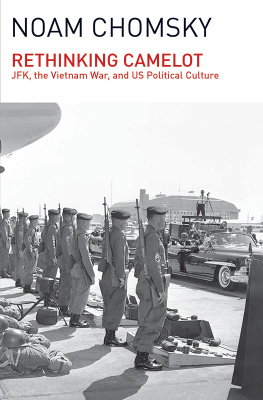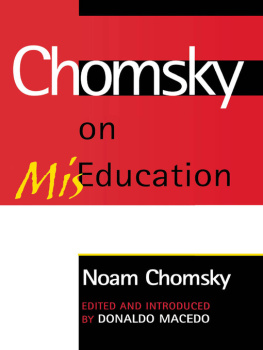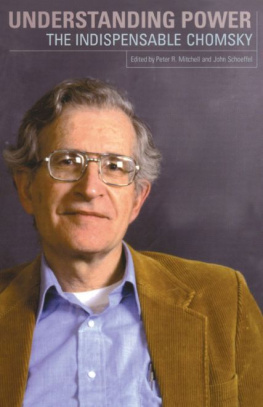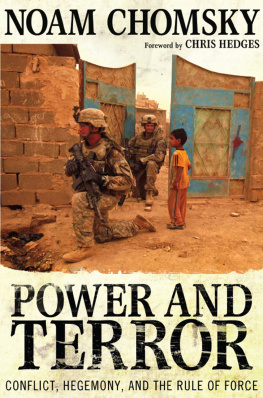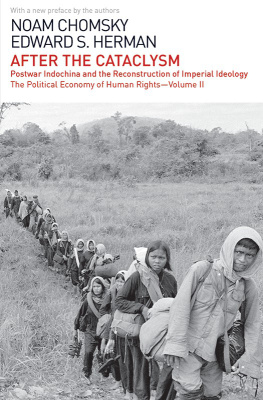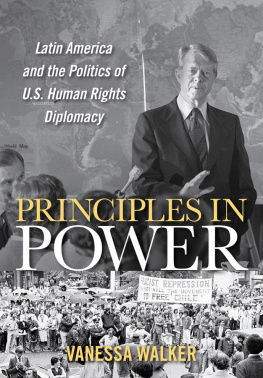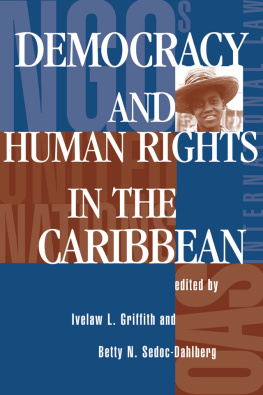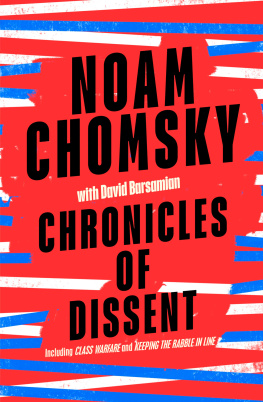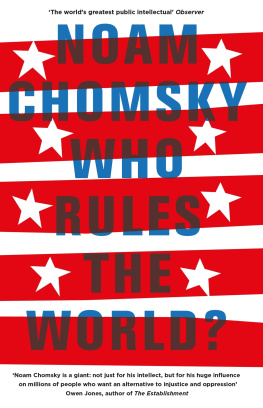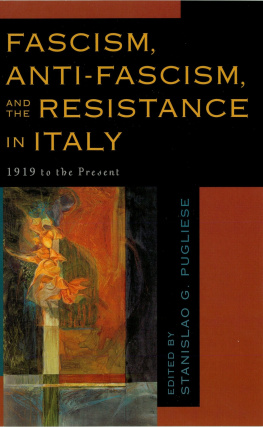The Washington Connection and Third World Fascism
For a discussion of this classification system, including both the basis for inclusion of countries and the criteria of parent-client relationship, see Frontispiece Footnotes, p 411, note 1.
* These countries underwent a significant political change in the 1970s, and are included here because they fit the classificationused torture on an adminstrative basisfor some part of the period.
+ Figure applies from 19501963.
No. of U.S.-trained military personnel 19501975 (in circles)
Total U.S. military aid 19461975 (on lines)
Gray tone indicates U.S. aid of training to police
Contents
The Political Economy of Human Rights Volume I
Haymarket Books
Chicago, Illinois
Noam Chomsky
and Edward S. Herman
The Washington Connection and Third World Fascism
Copyright 1979, Edward S. Herman and Noam Chomsky
First Edition published by South End Press, Boston, Massachusetts
This edition published in 2014 by
Haymarket Books
P.O. Box 180165
Chicago, IL 60618
773-583-7884
www.haymarketbooks.org
info@haymarketbooks.org
ISBN: 978-1-60846-406-7
Trade distribution:
In the US, Consortium Book Sales and Distribution, www.cbsd.com
In Canada, Publishers Group Canada, www.pgcbooks.ca
In the UK, Turnaround Publisher Services, www.turnaround-uk.com
All other countries, Publishers Group Worldwide, www.pgw.com
This book was published with the generous support of Lannan Foundation
and Wallace Action Fund.
Cover design by Josh On.
Library of Congress Cataloging-in-Publication data is available.
Bloodbaths in Indochina: Constructive, Nefarious and Mythical
The sheer scope and intensity of the violence imposed on Indochina by the U.S. war machine forced a great deal of information into the public domain and consciousness. The public was, nevertheless, spared a full picture of the wars true nature, and was kept in a state of confusion by a steady flow of allegations of enemy terror, assertions of Washingtons benevolent intentions, and the pretense that the enormous destruction of the civil societies of Indochina resulted from the fact that war inevitably hurts many innocent people. Enough got through the propaganda filter, however, to open many eyes to the ugly reality and to shatter the complacent faith of large numbers of Americans in the competence, humanity, and integrity of their leaders.
In reconstructing the faith it has been necessary to expunge from many memories the brutalities and lies of the war, and to transform the historical record so as to obfuscate its causes, minimize the toll it exacted upon its victims, and discount its meaning and historic significance. Much progress has been made along these lines by a simple process of non-discussion and suppression, allowing the war to fade, except where anti-Communist points can be scored. The propagandists have proven their mettle already on the crucial issue of cause and intent; they have succeeded in wiping the record clean of the substantial documentary evidence of rational imperial planning that provided the framework for the U.S. interventions, interpreting them more comfortably in terms of neutral categories such as error or ignorance in a framework of concern for freedom. A renewed effort has also commenced to show that the policies of search-and-destroy, harassment-and-interdiction fire, and napalming and high level bombing of densely populated areas were really not intended to kill civilians.
In volume II, we will consider the process of historical reconstruction in the context of analysis of Western reactions to developments in postwar Indochina. Here we will only review very briefly some salient features of the U.S. onslaught, soon to be lost in the mist of obfuscation and deceit as the propaganda system turns to the tasks that lie ahead. We will restrict the discussion to South Vietnam
5.1 Constructive Bloodbaths in Vietnam
5.1.1 French and Diemist Bloodbaths
Although the only pre-1965 bloodbath recognized in official doctrine is that which occurred in North Vietnam during its land reform of the mid-50s, there were others. In 1946, without warning, the French bombarded Haiphong, killing an estimated 6000 civilians, perhaps more than the number of victims of the well publicized North Vietnamese land reform episode (see section 5.2.2). But as part of the French recolonization effort, and with Vietnam of little interest to the American leadership, this bloodbath was ignored and has not been mentioned by U.S. official or non-official propagandists in their historical reconstructions of terror in Indochina.
Diems bloodbaths also were impressive, but as they were in the service of anti-Communism and the preservation of our client, they fall into the constructive or benign categories. Under our tutelage, Diem began his own search-and-destroy operations in the mid- and late 1950s, and his prison camps and the torture chambers were filled and active. In 1956 the official figure for political prisoners in South Vietnam was fifteen to twenty thousand. Even Diems friend and adviser, P. J. Honey, concluded on the basis of talks with former inmates, that the majority of these were neither Communists nor pro-Communists.
Pacification as it developed from the earliest Diem period consisted in killing, or arresting without either evidence or trials, large numbers of persons suspected of being Vietminh or rebels. This resulted in many small bloodbaths at the local level, plus larger ones associated with military expeditions carried out by Diem against the rural population. One former Vietminh resistance fighter gave the following account of the Diemist terror and bloodbath in his village:
My village chief was a stranger to the village. He was very cruel. He hunted all the former members of the Communist Party during the Resistance to arrest and kill them. All told, he slaughtered fourteen Party members in my village. I saw him with my own eyes order the killing of two Party members in Mau Lam hamlet. They had their hands tied behind their backs and they were buried alive by the militia. I was scared to death.
Another former resistance fighter in Central Vietnam claimed that
in 1956, the local government of Quang Nam started a terrorist action against old Resistance members. About 10,000 persons of the Resistance Army were arrested, and a good many of them were slaughtered. I had to run for my life, and I stayed in the mountains until 1960. I lived with three others who came from my village. We got help from the tribal population there.
The general mechanics of the larger bloodbaths were described by Joseph Buttinger, a former Diem supporter and advisor.
In June 1956 Diem organized two massive expeditions to the regions that were controlled by the Communists without the slightest use of force. His soldiers arrested tens of thousands of people...Hundreds, perhaps thousands of peasants were killed. Whole villages whose populations were not friendly to the government were destroyed by artillery. These facts were kept secret from the American people.
According to Jeffrey Race, a former U.S. Army advisor in South Vietnam who had access to extensive documentation on recent Vietnamese history,
...the government terrorized far more than did the revolutionary movementfor example, by liquidations of former Vietminh, by artillery and ground attacks on communist villages, and by roundups of communist sympathizers. Yet it was just these tactics that led to the constantly increasing strength of the revolutionary movement in Long An from 1960 to 1965.
During the period 1955-60 the Vietminh mission was political, and though it used assassinations and kidnapping, according to the Pentagon Papers historian it circumspectly avoided military operations.
Next page
